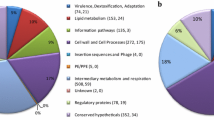Abstract
Ethambutol (EMB), one of the effective anti-mycobacterial drugs, inhibits the biosynthesis of mycobacterium cell wall. To elucidate the molecular mechanism of EMB against tuberculosis (TB), Mycobacterium smegmatis mc2155 was employed as a model of mycobacterial system in this study. We compared the protein profiles on M. smegmatis mc2155 treated by EMB and untreated using fluorescence difference two-dimensional gel electrophoresis (2-D DIGE). A total of 40 differential protein spots were selected and 22 proteins were identified by HPLC-nano ESI–MS/MS analysis, including 16 over-expressed proteins and 6 under-expressed proteins. These proteins mainly affected energy metabolism, as well as synthesis and modification of macromolecules. The expressions of correspondent genes were confirmed by RT-PCR. This investigation provided some clues for searching potential drug targets.


Similar content being viewed by others
References
Belanger AE, Besra GS, Ford ME, Mikusova K, Belisle JT, Brennan PJ, Inamine JM (1996) The embAB genes of Mycobacterium avium encode an arabinosyl transferase involved in cell wall arabinan biosynthesis that is the target for the antimycobacterial drug ethambutol. Proc Natl Acad Sci USA 93:11919–11924
Berger BJ, Knodel MH (2003) Characterisation of methionine adenosyltransferase from Mycobacterium smegmatis and M. tuberculosis. BMC Microbiol 3:12
Boshoff HI, Myers TG, Copp BR, McNeil MR, Wilson MA, Barry CE III (2004) The transcriptional responses of Mycobacterium tuberculosis to inhibitors of metabolism: novel insights into drug mechanisms of action. J Biol Chem 279:40174–40184
Deng L, Mikusova K, Robuck KG, Scherman M, Brennan PJ, McNeil MR (1995) Recognition of multiple effects of ethambutol on metabolism of mycobacterial cell envelope. Antimicrob Agents Chemother 39:694–701
Huang CC, Smith CV, Glickman MS, Jacobs WR Jr, Sacchettini JC (2002) Crystal structures of mycolic acid cyclopropane synthases from Mycobacterium tuberculosis. J Biol Chem 277:11559–11569
Kong TH, Coates AR, Butcher PD, Hickman CJ, Shinnick TM (1993) Mycobacterium tuberculosis expresses two chaperonin-60 homologs. Proc Natl Acad Sci USA 90:2608–2612
Mikusova K, Slayden RA, Besra GS, Brennan PJ (1995) Biogenesis of the mycobacterial cell wall and the site of action of ethambutol. Antimicrob Agents Chemother 39:2484–2489
Ojha A, Anand M, Bhatt A, Kremer L, Jacobs WR Jr, Hatfull GF (2005) GroEL1: a dedicated chaperone involved in mycolic acid biosynthesis during biofilm formation in mycobacteria. Cell 123:861–873
Raman K, Chandra N (2008) Mycobacterium tuberculosis interactome analysis unravels potential pathways to drug resistance. BMC Microbiol 8:234
Rozanas CR, Loyland SM (2008) Capabilities using 2-D DIGE in proteomics research: the new gold standard for 2-D gel electrophoresis. Methods Mol Biol 441:1–18
Starks AM, Gumusboga A, Plikaytis BB, Shinnick TM, Posey JE (2009) Mutations at embB codon 306 are an important molecular indicator of ethambutol resistance in Mycobacterium tuberculosis. Antimicrob Agents Chemother 53:1061–1066
Sun MZ, Liu S, Tang J, Wang Z, Gong X, Sun C, Greenaway F (2009) Proteomics analysis of two mice hepatocarcinoma ascites syngeneic cell lines with high and low lymph node metastasis rates provide potential protein markers for tumor malignancy attributes to lymphatic metastasis. Proteomics 9:3285–3302
Takayama K, Kilburn JO (1989) Inhibition of synthesis of arabinogalactan by ethambutol in Mycobacterium smegmatis. Antimicrob Agents Chemother 33:1493–1499
Telenti A, Philipp WJ, Sreevatsan S, Bernasconi C, Stockbauer KE, Wieles B, Musser JM, Jacobs WR Jr (1997) The emb operon, a gene cluster of Mycobacterium tuberculosis involved in resistance to ethambutol. Nat Med 3:567–570
Wang R, Marcotte EM (2008) The proteomic response of Mycobacterium smegmatis to anti-tuberculosis drugs suggests targeted pathways. J Proteome Res 7:855–865
Wang R, Prince JT, Marcotte EM (2005) Mass spectrometry of the M. smegmatis proteome: protein expression levels correlate with function, operons, and codon bias. Genome Res 15:1118–1126
Acknowledgments
This study is supported by the grants from National Natural Science Foundation of China (30970647), National Basic Research Program of China (2006CB504400) and Key Project of Major Infectious Diseases (2008ZX10003-006).
Author information
Authors and Affiliations
Corresponding author
Rights and permissions
About this article
Cite this article
Jiang, T., Zhan, Y., Sun, M. et al. The Novel Responses of Ethambutol Against Mycobacterium smegmatis mc2155 Revealed by Proteomics Analysis. Curr Microbiol 62, 341–345 (2011). https://doi.org/10.1007/s00284-010-9711-5
Received:
Accepted:
Published:
Issue Date:
DOI: https://doi.org/10.1007/s00284-010-9711-5




